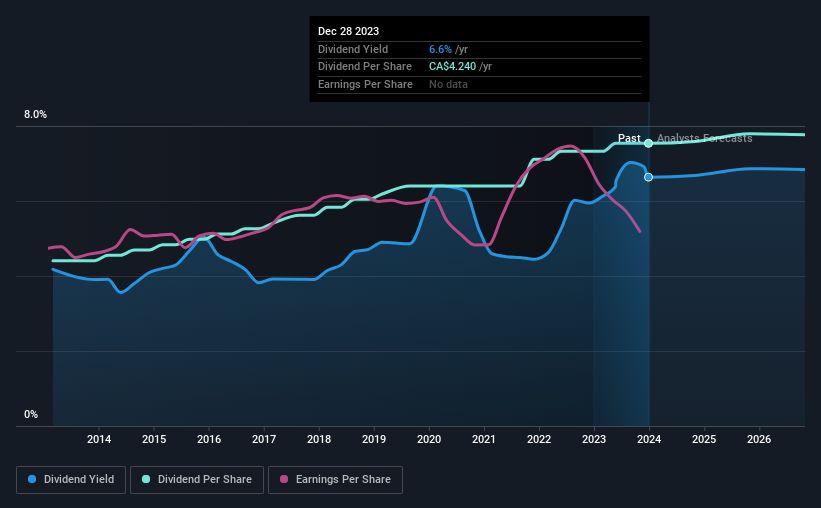Don't Race Out To Buy The Bank of Nova Scotia (TSE:BNS) Just Because It's Going Ex-Dividend
The Bank of Nova Scotia (TSE:BNS) stock is about to trade ex-dividend in 4 days. The ex-dividend date is one business day before the record date, which is the cut-off date for shareholders to be present on the company's books to be eligible for a dividend payment. The ex-dividend date is important as the process of settlement involves two full business days. So if you miss that date, you would not show up on the company's books on the record date. Meaning, you will need to purchase Bank of Nova Scotia's shares before the 2nd of January to receive the dividend, which will be paid on the 29th of January.
The company's next dividend payment will be CA$1.06 per share. Last year, in total, the company distributed CA$4.24 to shareholders. Last year's total dividend payments show that Bank of Nova Scotia has a trailing yield of 6.6% on the current share price of CA$63.9. Dividends are an important source of income to many shareholders, but the health of the business is crucial to maintaining those dividends. So we need to investigate whether Bank of Nova Scotia can afford its dividend, and if the dividend could grow.
See our latest analysis for Bank of Nova Scotia
Dividends are usually paid out of company profits, so if a company pays out more than it earned then its dividend is usually at greater risk of being cut. Bank of Nova Scotia paid out more than half (72%) of its earnings last year, which is a regular payout ratio for most companies.
Companies that pay out less in dividends than they earn in profits generally have more sustainable dividends. The lower the payout ratio, the more wiggle room the business has before it could be forced to cut the dividend.
Click here to see the company's payout ratio, plus analyst estimates of its future dividends.

Have Earnings And Dividends Been Growing?
Companies with falling earnings are riskier for dividend shareholders. If earnings fall far enough, the company could be forced to cut its dividend. That's why it's not ideal to see Bank of Nova Scotia's earnings per share have been shrinking at 3.5% a year over the previous five years.
Many investors will assess a company's dividend performance by evaluating how much the dividend payments have changed over time. Bank of Nova Scotia has delivered 5.5% dividend growth per year on average over the past 10 years. Growing the dividend payout ratio while earnings are declining can deliver nice returns for a while, but it's always worth checking for when the company can't increase the payout ratio any more - because then the music stops.
The Bottom Line
From a dividend perspective, should investors buy or avoid Bank of Nova Scotia? We're not overly enthused to see Bank of Nova Scotia's earnings in retreat at the same time as the company is paying out more than half of its earnings as dividends to shareholders. This is not an overtly appealing combination of characteristics, and we're just not that interested in this company's dividend.
Curious what other investors think of Bank of Nova Scotia? See what analysts are forecasting, with this visualisation of its historical and future estimated earnings and cash flow.
If you're in the market for strong dividend payers, we recommend checking our selection of top dividend stocks.
Have feedback on this article? Concerned about the content? Get in touch with us directly. Alternatively, email editorial-team (at) simplywallst.com.
This article by Simply Wall St is general in nature. We provide commentary based on historical data and analyst forecasts only using an unbiased methodology and our articles are not intended to be financial advice. It does not constitute a recommendation to buy or sell any stock, and does not take account of your objectives, or your financial situation. We aim to bring you long-term focused analysis driven by fundamental data. Note that our analysis may not factor in the latest price-sensitive company announcements or qualitative material. Simply Wall St has no position in any stocks mentioned.

 Yahoo Finance
Yahoo Finance 